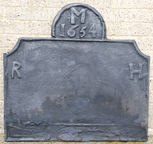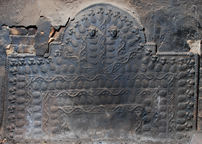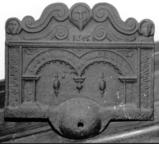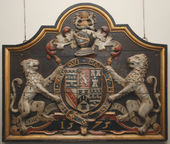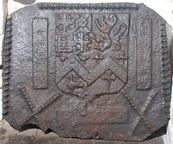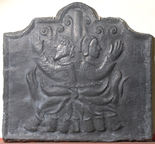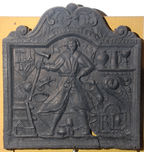-
277
Description: Arched rectangular with cavetto-moulding along top, supported by Ionic pilasters; English Stuart royal shield, garter, helm, crown, motto and supporters; date below and either side of garter.
Notes: One of several firebacks, all of the same date, but varying in size, framing style and moulding; all have stylistic features in common and will have been the work of the same pattern maker, who was also responsible for carving royal coats of arms in three West Country churches. Mendip Auctions, Binegar, 11 Dec 2021, lot 537.
Copies of this fireback are known.
Inscription: I R [Jacobus Rex] / HONI SOIT QVI MAL Y PENSE / 16 18 / DIEV ET MON DROIT
Arms: English Stuart royal (James I)
- Decoration tags:
- rectangular with round arch (shape)
- complex individual (edging)
- whole carved pattern
- architectural
- armorial
- royal
- text
Manufactured: in 1618 possibly in the Forest of Dean area of England.
Current location: not known.
-
878
Description: Cavetto-canted arched rectangle; twisted rope edging, separately around rectangle and arch; initials 'R' and 'H' in upper left and right corners of rectangle; 'M' above date in arch.
Notes: The arch does not appear to have been a separate stamp, although the rope edging gives that impression; the initials, in triad, suggest a husband and wife - R.. and H.. M..
Inscription: M / 1654 / / R H
- Decoration tags:
- rectangular with canted top corners and round arch (shape)
- rope (edging)
- simple stamps
- carved stamps
- individual letters
- individual numbers
- text
Manufactured: in 1654 possibly in the Weald area of England.
Current location: in private hands, Birling, Kent, England.
- Attached to series:
- Date & initials firebacks
-
40
Description: Pentagonal; convex, twisted cloth edging with inner fillet; Tudor royal shield, garter, crown and supporters (crowned lion and dragon); initials split by crown; date split by garter buckle.
Notes: Royal arms of Queen Elizabeth I; uncommon edging.
Inscription: E R / HONY SOIT QVI MAL Y PENSE / 1585
Arms: Tudor royal (Elizabeth I)
- Decoration tags:
- triangular arched (shape)
- convex, twisted cloth with inner fillet (edging)
- whole carved pattern
- individual numbers
- armorial
- royal
- text
Manufactured: in 1585 in the Weald area of England.
Current location: in private hands, Cuckfield, West Sussex, England.
- Attached to series:
- Elizabethan royal armorial firebacks
- Tudor royal armorial firebacks
-
72
Description: Arched rectangular shape with stepped angles; twisted rope edging (top and sides); small flower bud stamp repeated inside edging, with ‘pineapple’ stamp repeated inside; lower part comprises three concentric half-rectangles formed from undulating vine strips and repeated ‘pineapple’ stamp; above, three vertical vine strips with parallel ‘pineapple’ stamps, human face stamps above them; two diagonal vine strips below the vertical strips.
Notes: A most remarkable fireback, incorporating stamps seen on other firebacks.
- Decoration tags:
- rectangular with round arch (shape)
- rope (edging)
- simple stamps
- carved stamps
- humans
- plants
- objects
Manufactured: in the late-16th century possibly at Pounsley Furnace, Framfield in the Weald area of England.
Current location: in private hands, Grayswood, Surrey, England.
- Attached to series:
- Pounsley series
- Vine strip series
- Furniture stamp firebacks
- Figurine firebacks
-
123
Description: Rectangular; top panel with bearded face between symmetrical horizontal scrolls, and faces at either end; scrolls are repeated below, on either side of the date, all above a horizontal double fillet; below, a pair of arches with guilloche decoration between fillets, and toothed on the underside, are supported on each side by Tuscan columns, also with guilloche decoration; this is repeated in symmetrical rectangular panels on either side; at the centre base a bulbous nozzle protrudes.
Notes: This is a smith's forge fireback, the nozzle being the tuyere directing the air into the fire from bellows behind. Stylistically similar to the Lenard and other firebacks of the same period, the carved elements above the nozzle may have been cast from a pattern inspired by the back of a joined 'wainscot' chair, with the date inserted. The back may have been used for forging non-ferrous metals as there was a trade in pot-founding in bronze as well as iron at some ironworks in the Weald. Formerly part of the Ade Collection (from Grove Hill, Hellingly, Sussex).
Inscription: 1655
- Decoration tags:
- rectangular with round arch (shape)
- fillet (edging)
- whole carved pattern
- individual numbers
- architectural
- text
- humans
Manufactured: in 1655 in the Weald area of England.
Current location: Hastings Museum and Art Gallery, John's Place, Bohemia Road, Hastings, East Sussex, England.
Museum number: HASMG: 1952.51.62 (part of the Hastings Museum museum group)
Citation: Butterfield, W. R., 1916, 'Old Wealden Firebacks', The Connoisseur, 46, pp. 197-209.
- Attached to series:
- Chair pattern firebacks
- Furniture stamp firebacks
-
926
Description: Carved wooden fireback pattern. Cavetto-canted rectangle with arch; ovolo-moulded edging; shield, garter, helm, mantling, crest, motto and supporters of William Cecil, 1st Lord Burghley, KG (1520-98). Date below garter.
Notes: William Cecil was Queen Elizabeth I's first minister. Owing to Lord Burghley's motto being merely painted and not carved, as the Garter motto is, the primary purpose of this armorial was probably decorative, and its role as a pattern for firebacks secondary.
Inscription: HONI SOIT QUI MAL Y PENSE / COR VNVM [ET] VIA VNA / 15 75
Arms: William Cecil, KG, 1st Baron Burghley
- Decoration tags:
- rectangular (shape)
- ovolo (edging)
- whole carved pattern
- planklines
- armorial
- text
Manufactured: in 1575 in England.
Current location: Hatfield House, Hatfield, Hertfordshire, England.
- Attached to series:
- Patterns
- Personal armorial firebacks
-
188
Description: Cavetto-canted rectangle with arch; ovolo-moulded edging; shield, garter, helm, mantling, crest and supporters of William Cecil, 1st Lord Burghley, KG (1520-98). Date below garter.
Notes: William Cecil was Queen Elizabeth I's first minister. The wooden pattern for this fireback (no. 926), itself a fine carved, wooden painted panel, is at Hatfield House, Hertfordshire.
Copies of this fireback are known.
Inscription: HONI SOIT QUI MAL Y PENSE 15 75
Arms: William Cecil, KG, 1st Baron Burghley
- Decoration tags:
- rectangular with canted top corners and round arch (shape)
- ovolo (edging)
- whole carved pattern
- planklines
- armorial
- text
Manufactured: in 1575 possibly in the Weald area of England.
Current location: Hatfield House, Hatfield, Hertfordshire, England.
- Attached to series:
- Personal armorial firebacks
- Armorial panel firebacks
-
334
Description: Quasi-rectangular; twisted rope lengths along top and sides; centre top, quartered shield between two vertical carved stamps of a billet with five oval shapes; the same billet is repeated horizontally below between two irregular twisted rope saltires.
Notes: The arms are probably of Thomas Wriothesley, who was Henry VIII's last Lord Chancellor and created Earl of Southampton in 1547; he married c.1533 so the arms could date to before then, but the same arms are displayed on his enamelled stall plate in St George's Chapel, Windsor, of 1545, and in stained glass in a window in the parish church at South Warnborough, Hampshire. The shield is, quarterly, 1. Wrythe or Wriothesley quartering Dunstanville and Pink, 2. Drayton, 3. Crocker and 4. Peckham. A candidate for the earliest English fireback with an example of personal arms. A similar fireback is no. 1305.
Arms: Wriothesley (Earl of Southampton)
- Decoration tags:
- rectangular (shape)
- rope (edging)
- simple stamps
- carved stamps
- armorial
- objects
Manufactured: in the mid- to late-16th century in the Weald area of England.
Current location: in private hands, Huddington, Worcestershire, England.
Citation: Gardner, J. S., 25 May 1907, 'Old Wealden Ironwork at Warnham Court', Country Life, pp. 730-2.
- Attached to series:
- Personal armorial firebacks
- Royal series
- Wriothesley firebacks
-
396
Description: Cavetto-canted rectangle with arched top; astragal and cavetto edging (top and sides); pictorial; back-to-back figures of a bearded man and a woman in a poke bonnet, both dressed in tunics, their arms raised, respectively left and right; they are chained to a vertical pole; below, flames issue from vertically stacked logs, while smoke rises above them; the physical proportions of the figures are naïve, the man’s eyes being over-large, as are the hands of both.
Notes: The design is a free adaptation of an illustration from The Book of Martyrs by John Foxe (1563), a copy from a back originally noted at Brick Cottage, Burwash, Sussex, in 1871. This may be the design of fireback referred to in an enquiry printed in the St James's Chronicle, or British Evening Post, of 9 August 1788, which described it as 'having two Bishops burning at Stakes thereon' at a house in Warwickshire. At an auction sale in 2017 the same design of fireback was interpreted as the burning of Bishops Latimer and Ridley in 1555. Protestants were burnt to death at several Wealden locations as well as elsewhere in the south-east of England during the reign of Mary I, notably at Canterbury and Lewes. The subject of the fireback should be regarded as symbolic rather than commemorating any individual martyrs.
Copies of this fireback are known.
- Decoration tags:
- rectangular with canted top corners and round arch (shape)
- astragal with cavetto (edging)
- whole carved pattern
- pictorial
- historical
- humans
Manufactured: in the late-16th to early-17th century in the Weald area of England.
Current location: Anne of Cleves House, Southover High Street, Lewes, East Sussex, England.
Museum number: LH000.903 (part of the Sussex Archaeological Society museum group)
Citation: Butterfield, W. R., 1916, 'Old Wealden Firebacks', The Connoisseur, 46, pp. 197-209.
Citation: Dawson, C., 1903, 'Sussex Iron Work and Pottery', Sussex Archaeological Collections, 46, pp. 1-54.
Citation: Paine, C., Aug 2013, 'Mystery of the Two Martyrs', Sussex Past and Present, 130, pp. 6-7.
Citation: Straker, E., 1931, Wealden Iron (London, Bell).
- Attached to series:
- Commemorative firebacks
-
429
Description: Arched rectangular shape with symmetrical floral scrolls on top; three horizontal plank lines; ovolo moulding all round edge of main panel; inscription along top edge of panel; central figure of a bearded man wearing knee-length coat, belted at waist, and holding a sledge hammer in his right hand, his left arm akimbo; both feet pointing to his right; various ‘tools’ of his trade arranged about him; (clockwise from top left) shield, the quarters containing a masonry hammer, a firedog, a weight, and a pair of pincers; the date split on either side of his head; a floral console supporting a shelf bearing a flagon, a tankard and a goblet; a fireback bearing the letters RL and a diamond shape; from the top of the fireback a dog leaping up at its master; between the man's legs a long-handled ladle, a weight and a cooking pot; a ringer, used to pull slag off molten iron; part of the elevation of a blast furnace, with wooden framework, casting house, and flames issuing from the top; an ore basket, wheelbarrow and a charcoal clamp
Notes: The 'Lenard' fireback; a much-copied plate. Items relating to the founder's working life are displayed to the left of the figure, those to the right reflecting his domestic life. Its individualistic design and naïve figuration are the key to identifying a distinct group of firebacks, all probably made at Brede. A pastiche of this fireback also exists (no. 668), with which it is sometimes confused.
Copies of this fireback are known.
Inscription: RICHARD LENARD FOVNDER AT BRED FOVRNIS [each D is reversed] / 1636 / RL
- Decoration tags:
- rectangular with round arch (shape)
- ovolo (edging)
- whole carved pattern
- planklines
- pictorial
- historical
- text
- animals
- humans
- objects
Manufactured: in 1636 at Brede Furnace in the Weald area of England.
Current location: Anne of Cleves House, Southover High Street, Lewes, East Sussex, England.
Museum number: LH000.906 (part of the Sussex Archaeological Society museum group)
Citation: Anon., 30 Dec 1911, 'Sussex Backs and their Story', The Ironmonger.
Citation: Dawson, C., 1903, 'Sussex Iron Work and Pottery', Sussex Archaeological Collections, 46, pp. 1-54.
Citation: Gardner, J. S., 1898, 'Iron Casting in the Weald', Archaeologia, 56, 1, pp. 133-164.
- Attached to series:
- Brede group
- Personal firebacks

